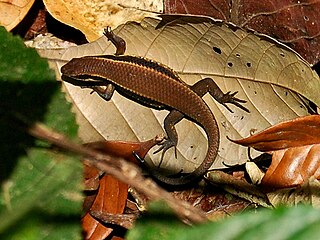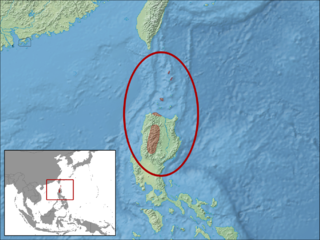
Gabriel Bibron was a French zoologist and herpetologist. He was born in Paris. The son of an employee of the Museum national d'histoire naturelle, he had a good foundation in natural history and was hired to collect vertebrates in Italy and Sicily. Under the direction of Jean Baptiste Bory de Saint-Vincent (1778–1846), he took part in the Morea expedition to Peloponnese.
Eutropis ashwamedhi, also known as the Ashwamedh writhing skink or Ashwamedha supple skink, is a species of skink found in India.
Eutropis beddomei, commonly known as Beddome's skink or Beddome's mabuya, is a species of skink endemic to India and Sri Lanka.

Eutropis bibronii, also known commonly as Bibron's skink or the seashore skink, is a species of skink, a lizard in the family Scincidae. The species is endemic to India and Sri Lanka.

Eutropis clivicola, known as Inger's mabuya or mountain skink, is a species of skink found in India (Kerala). It was first formally described in 1984 as Mabuya clivicola.
Eutropis gansi, also known as Gans's mabuya and Gans's grass skink , is a species of skink, a lizard in the family Scincidae. The species is endemic to the southern Western Ghats, India.

The bronze grass skink, bronze mabuya or speckled forest skink, is a species of skink found in South and Southeast Asia. It is a common, but shy, ground-dwelling species that is active both day and night.

Eutropis multifasciata, commonly known as the East Indian brown mabuya, many-lined sun skink, many-striped skink, common sun skink or (ambiguously) as golden skink, is a species of skink.

The rough mabuya or brown mabuya is a species of skink. It is found in the Maritime Southeast Asia: Indonesia, Malaysia, Philippine Islands, Sulu Islands, as well as on the Nicobar islands of India.

Eutropis rugifera, variously known as Nicobar Island skink or rough-scaled sun skink, is a species of skink from southeastern Asia.
Labeo lankae is a species of cyprinid fish. It is endemic to Sri Lanka.
Miocaretta is an extinct genus of sea turtle from the Miocene era in what is now Sri Lanka. It was first named by Paul E. P. Deraniyagala in 1967. The type and only species is M. lankae.

Eutropis is a genus of skinks belonging to the subfamily Mabuyinae. For long, this genus was included in the "wastebin taxon" Mabuya; it contains the Asian mabuyas. They often share their habitat with the related common skinks (Sphenomorphus), but they do not compete significantly as their ecological niches differ. This genus also contains the only member of the subfamily to occur in Australasia, the many-lined sun skink, whose wide range includes New Guinea.

Eutropis longicaudata, the longtail mabuya or long-tailed sun skink, is a species of skink. It is found in southern China, Hong Kong, Taiwan, Laos, Vietnam, Thailand, Cambodia, and Peninsular Malaysia.
Eutropis madaraszi, also known as Sri Lanka bronze mabuya, Sri Lanka bronze skink, or (ambiguously) spotted skink, is a species of skink endemic to island of Sri Lanka.

The Luzon montane mabouya is a species of skink found in Luzon in the Philippines.

Eutropis cumingi, also known as the Cuming's mabouya, is a species of skink. It is found in the northern parts of the Philippines as well as in Orchid Island southeast of Taiwan. It is named after its first collector, Hugh Cuming.

The six-striped mabouya is a species of skink found in Mindanao in the Philippines.
Eutropis borealis is a species of skink. Before being elevated to full-species rank in 2020, it was considered a subspecies of Eutropis multicarinata.











